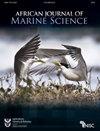Network analysis of the endemic spotted gully shark Triakis megalopterus reveals spatial vulnerability to exploitation in the Western Cape, South Africa
IF 1.4
4区 生物学
Q3 MARINE & FRESHWATER BIOLOGY
引用次数: 0
Abstract
The spotted gully shark Triakis megalopterus (Triakidae) is a mesopredatory species endemic to southern Africa. It is currently listed as Least Concern on the IUCN Red List in accordance with an estimated increase in population size, general release by recreational linefishers and incidental catches in the commercial linefisheries. Previous research suggests this species to be resident, and as such it is likely to receive protection in coastal marine protected areas (MPAs). However, its ecology and movement behaviour remain poorly studied. This study employed acoustic telemetry to provide information on the species’ movements along the coast of the Western Cape Province, South Africa. We used network analyses to investigate movement randomness, associations between individuals, sexual segregation, and the effectiveness of MPAs. Our findings reveal nonrandom movements as well as patterns of co-occurrence between individuals. Spatial network analysis suggested sexual segregation, because areas of high use (Walker Bay and De Hoop) differed between males and females. Co-occurrences were observed exclusively in Walker Bay, chiefly between males, with no co-occurrence found between females. The tagged spotted gully sharks were not detected extensively within existing MPA boundaries, though there was no significant difference between their movements inside and outside protected areas for both sexes.对南非特有的斑沟鲨 Triakis megalopterus 的网络分析揭示了其在南非西开普省易受开发利用的空间脆弱性
斑沟鲨(Triakis megalopterus)是南部非洲特有的中型食肉鱼种。根据估计的种群数量增长、休闲延绳钓渔民的普遍放生以及商业延绳钓渔场的意外捕获,该物种目前在世界自然保护联盟红色名录中被列为最不关注物种。以前的研究表明,该物种是常住物种,因此可能会受到沿海海洋保护区(MPAs)的保护。然而,对其生态学和移动行为的研究仍然很少。本研究利用声学遥测技术提供了该物种在南非西开普省沿海的活动信息。我们使用网络分析来研究其移动的随机性、个体之间的关联、性隔离以及海洋保护区的有效性。我们的研究结果揭示了非随机运动以及个体间的共存模式。空间网络分析表明存在性隔离,因为雄性和雌性的高使用率区域(沃克湾和德霍普)是不同的。只在沃克湾观察到雄性之间的共同出现,没有发现雌性之间的共同出现。在现有的海洋保护区范围内没有广泛地发现被标记的斑点叉尾鲨,尽管雌雄斑点叉尾鲨在保护区内外的活动没有显著差异。
本文章由计算机程序翻译,如有差异,请以英文原文为准。
求助全文
约1分钟内获得全文
求助全文
来源期刊

African Journal of Marine Science
生物-海洋与淡水生物学
CiteScore
2.60
自引率
16.70%
发文量
17
审稿时长
6-12 weeks
期刊介绍:
The African (formerly South African) Journal of Marine Science provides an international forum for the publication of original scientific contributions or critical reviews, involving oceanic, shelf or estuarine waters, inclusive of oceanography, studies of organisms and their habitats, and aquaculture. Papers on the conservation and management of living resources, relevant social science and governance, or new techniques, are all welcomed, as are those that integrate different disciplines. Priority will be given to rigorous, question-driven research, rather than descriptive research. Contributions from African waters, including the Southern Ocean, are particularly encouraged, although not to the exclusion of those from elsewhere that have relevance to the African context. Submissions may take the form of a paper or a short communication. The journal aims to achieve a balanced representation of subject areas but also publishes proceedings of symposia in dedicated issues, as well as guest-edited suites on thematic topics in regular issues.
 求助内容:
求助内容: 应助结果提醒方式:
应助结果提醒方式:


